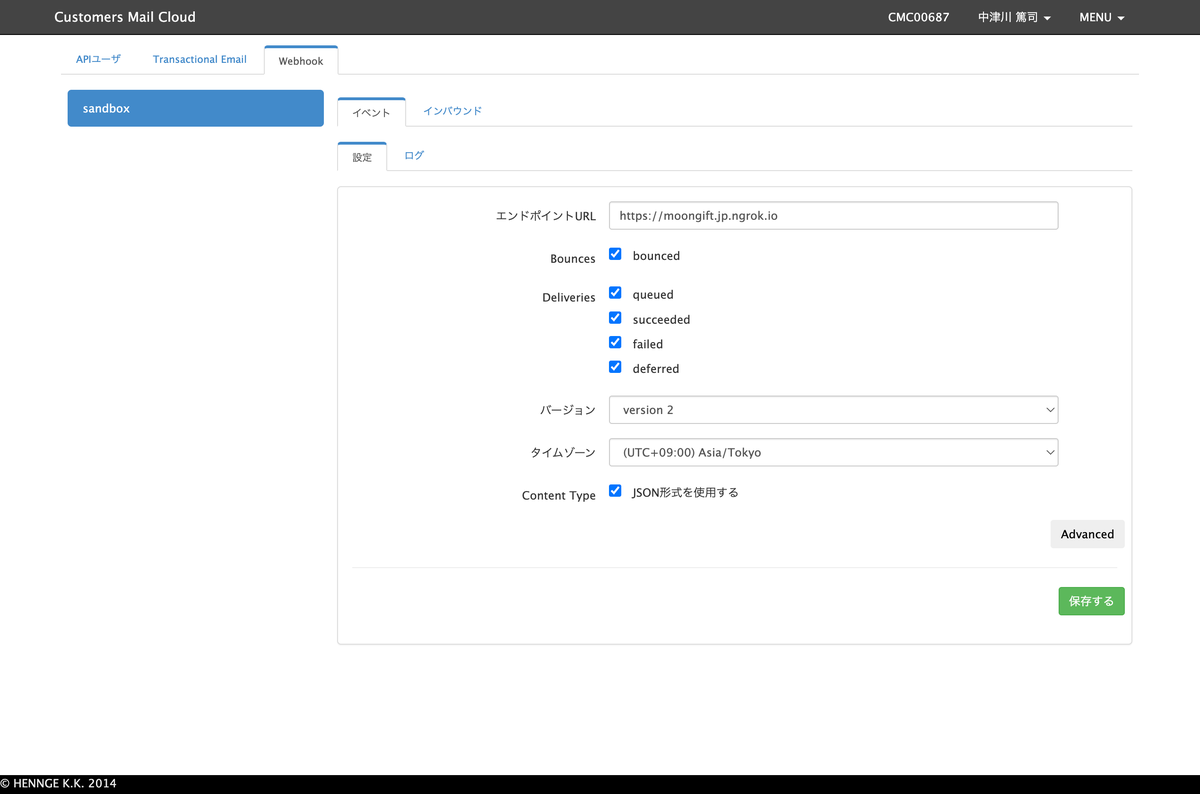Customers Mail CloudのWebhookは2種類あります。
- メール受信時
- メール送信時
メール送信時は、送信したメールに対してステータスが変わったタイミングで通知が送られるものです。
本記事では実際にどういった内容が送られてくるのかを紹介します。
受け取るWebhookの設定
管理画面にて、受け取るWebhookを設定できます。設定は以下が用意されています。
- Bounces
- bounced(エラーメールを受け取る)
- Deliveries
- queued(キューに入ったタイミング)
- succeeded(送信完了)
- failed(送信失敗)
- deferred(送信延期)

送信されてくるデータについて
メール送信した直後
メール送信を行うと、そのデータがキューに入ります。そして、以下のようなWebhookが送られてきます(データは一部マスキングしています)。
{ "event_type": "deliveries", "server_composition": "pro", "event": { "deliveries": [ { "reason": "", "sourceIp": "100.100.100.1", "returnPath": "info@return.pro.smtps.jp", "created": "2023-01-25 14:03:06", "subject": "メールマガジンのテスト", "apiData": "", "messageId": "<031a32d4-06cd-b1ae-9526-011c0b9f1296@example.com>", "from": "info@example.com", "to": "user@example.jp", "senderIp": "", "status": "queued" } ] } }
メール送信完了時
Customers Mail Cloudからメール送信処理が行われると、ステータスが succeeded になったWebhookが送られてきます。
{ "event_type": "deliveries", "server_composition": "pro", "event": { "deliveries": [ { "reason": "", "sourceIp": "", "returnPath": "info@return.pro.smtps.jp", "created": "2023-01-25 14:03:09", "subject": "メールマガジンのテスト", "apiData": "", "messageId": "<031a32d4-06cd-b1ae-9526-011c0b9f1296@example.com>", "from": "info@example.com", "to": "user@example.jp", "senderIp": "100.100.100.3", "status": "succeeded" } ] } }
メール送信失敗時(メールアドレス形式に問題がある場合)
メールアドレスの形式に問題があるなど、送信処理が失敗した場合には以下のようなWebhookが送られてきます。
{ "event_type": "bounces", "server_composition": "pro", "event": { "bounces": [ { "reason": "host unknown", "returnPath": "info@return.pro.smtps.jp", "created": "2023-01-25 14:05:15", "subject": "メールマガジンのテスト", "apiData": "", "messageId": "<8f902ee7-ae65-8711-48a8-2f708cb14205@example.com>", "from": "info@example.com", "to": "user@example", "status": "1" } ] } }
メール送信失敗時(送信先サーバーからエラーが返ってくる場合)
ユーザーが存在しない、メールボックスがいっぱいなど送信先サーバーからエラーが返ってきた場合には、以下のようなJSONが返ってきます。
{ "event_type": "deliveries", "server_composition": "pro", "event": { "deliveries": [ { "reason": "550 5.1.1 The email account that you tried to reach does not exist. Please try 5.1.1 double-checking the recipient's email address for typos or 5.1.1 unnecessary spaces. Learn more at 5.1.1 <https://support.google.com/mail/?p=NoSuchUser> b197-20020a621bce000000b0058b80756b07si311029pfb.3 - gsmtp (in reply to RCPT TO)", "sourceIp": "", "returnPath": "info@return.pro.smtps.jp", "created": "2023-01-25 14:06:06", "subject": "メールマガジンのテスト", "apiData": "", "messageId": "<9e7e564c-ac83-8cd8-2cb4-b9ff2a9f168d@example.com>", "from": "info@example.com", "to": "no-user@example.jp", "senderIp": "100.100.100.3", "status": "failed" } ] } }
エラーとしてのWebhookも送られてきます。上記のものと event_type が異なるので注意してください。
{ "event_type": "bounces", "server_composition": "pro", "event": { "bounces": [ { "reason": "550 5.1.1 The email account that you tried to reach does not exist. Please try 5.1.1 double-checking the recipient's email address for typos or 5.1.1 unnecessary spaces. Learn more at 5.1.1 <https://support.google.com/mail/?p=NoSuchUser> b197-20020a621bce000000b0058b80756b07si311029pfb.3 - gsmtp (in reply to RCPT TO)", "returnPath": "info@return.pro.smtps.jp", "created": "2023-01-25 14:06:07", "subject": "メールマガジンのテスト", "apiData": "", "messageId": "<9e7e564c-ac83-8cd8-2cb4-b9ff2a9f168d@example.com>", "from": "info@example.com", "to": "no-user@example.jp", "status": "2" } ] } }
Azure Functionsの準備
まずAzure Functionsにて関数を作成します。Azure FunctionsはVisual Studio Codeから作成できます。ウィザードに沿って進めていくだけで作成できるので簡単です。
今回は .NET6 を使い、HTTPトリガーを選択しています。また、ネームスペースは Smtps.Function で、関数名は CMCWebhook としています。
関数を作成する
関数のベースは以下のようになります。レスポンスはJSONで、 {"result": "ok"} という文字列を返すようにしています。
using System.IO;
using System.Threading.Tasks;
using Microsoft.AspNetCore.Mvc;
using Microsoft.Azure.WebJobs;
using Microsoft.Azure.WebJobs.Extensions.Http;
using Microsoft.AspNetCore.Http;
using Microsoft.Extensions.Logging;
using Newtonsoft.Json;
using System.Collections.Generic;
namespace Smtps.Function
{
public static class CMCWebhook
{
[FunctionName("CMCWebhook")]
public static async Task<IActionResult> Run(
[HttpTrigger(AuthorizationLevel.Function, "post", Route = null)] HttpRequest req,
ILogger log)
{
return new ContentResult(){Content = "{\"result\": \"ok\"}", ContentType = "application/json"};
}
}
}
クラスの作成
送られてくるJSONをデシリアライズするために、クラスを作成します。以下のようになります。
public class EventType
{
public string reason { get; set; }
public string returnPath { get; set; }
public string created { get; set; }
public string subject { get; set; }
public string apiData { get; set; }
public string messageId { get; set; }
public string from { get; set; }
public string to { get; set; }
public string status { get; set; }
}
public class Event
{
public List<EventType> bounces { get; set; }
public List<EventType> deliveries { get; set; }
public List<EventType> blocks { get; set; }
}
public class Email
{
public string event_type { get; set; }
public string server_composition { get; set; }
public Event @event { get; set; }
}
デシリアライズする
デシリアライズする際には Email クラスを指定します。 Email クラスには、JSONデータのキー名と同じ名前のプロパティが定義されていますので、自動的にデシリアライズされます。
var sr = new StreamReader(req.Body); var email = JsonConvert.DeserializeObject<Email>(await sr.ReadToEndAsync()); log.LogInformation(email.event_type); log.LogInformation(email.@event.bounces[0].reason);
全体のコード
関数全体のコードは以下のようになります。
using System.IO;
using System.Threading.Tasks;
using Microsoft.AspNetCore.Mvc;
using Microsoft.Azure.WebJobs;
using Microsoft.Azure.WebJobs.Extensions.Http;
using Microsoft.AspNetCore.Http;
using Microsoft.Extensions.Logging;
using Newtonsoft.Json;
using System.Collections.Generic;
public class EventType
{
public string reason { get; set; }
public string returnPath { get; set; }
public string created { get; set; }
public string subject { get; set; }
public string apiData { get; set; }
public string messageId { get; set; }
public string from { get; set; }
public string to { get; set; }
public string status { get; set; }
}
public class Event
{
public List<EventType> bounces { get; set; }
public List<EventType> deliveries { get; set; }
public List<EventType> blocks { get; set; }
}
public class Email
{
public string event_type { get; set; }
public string server_composition { get; set; }
public Event @event { get; set; }
}
namespace Smtps.Function
{
public static class CMCWebhook
{
[FunctionName("CMCWebhook")]
public static async Task<IActionResult> Run(
[HttpTrigger(AuthorizationLevel.Function, "post", Route = null)] HttpRequest req,
ILogger log)
{
var sr = new StreamReader(req.Body);
var email = JsonConvert.DeserializeObject<Email>(await sr.ReadToEndAsync());
log.LogInformation(email.event_type);
log.LogInformation(email.@event.bounces[0].reason);
return new ContentResult(){Content = "{\"result\": \"ok\"}", ContentType = "application/json"};
}
}
}
まとめ
Webhookを使うことで、メール送信ステータスの変化に応じて通知を受け取れるようになります。メールと連携したシステムを開発する際に役立つでしょう。
このWebhookはSMTP経由の場合、利用できます。ぜひご利用ください。
